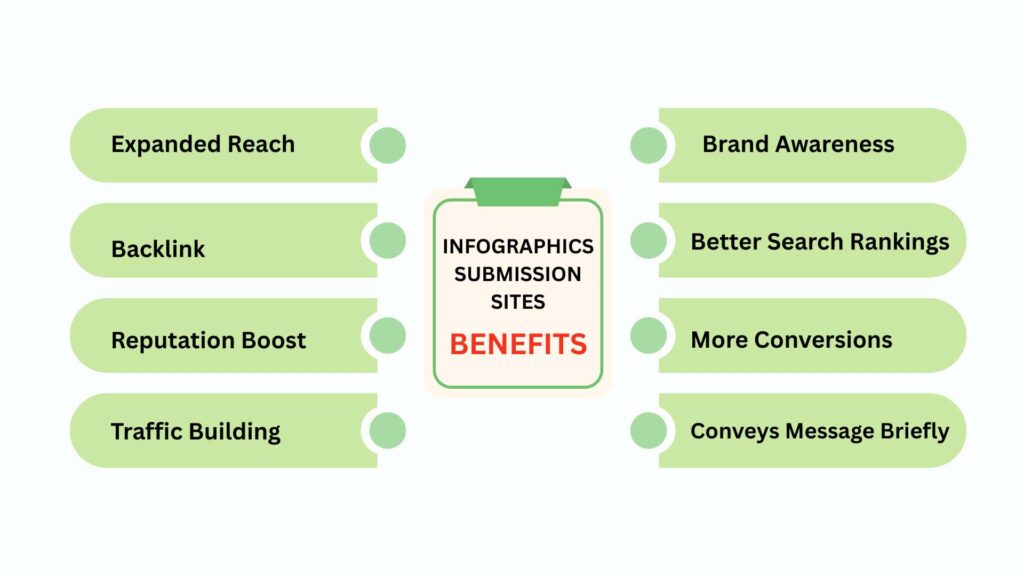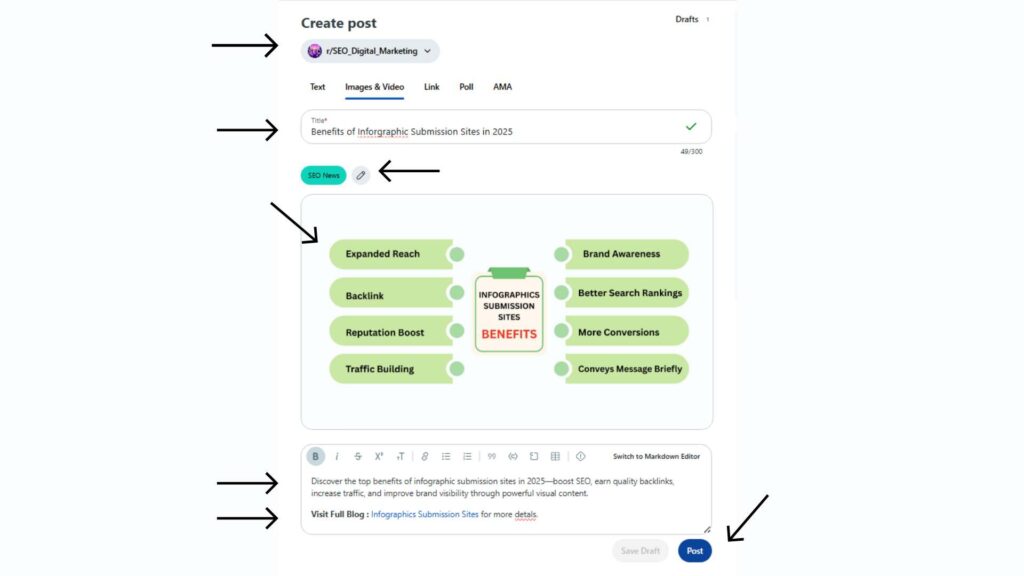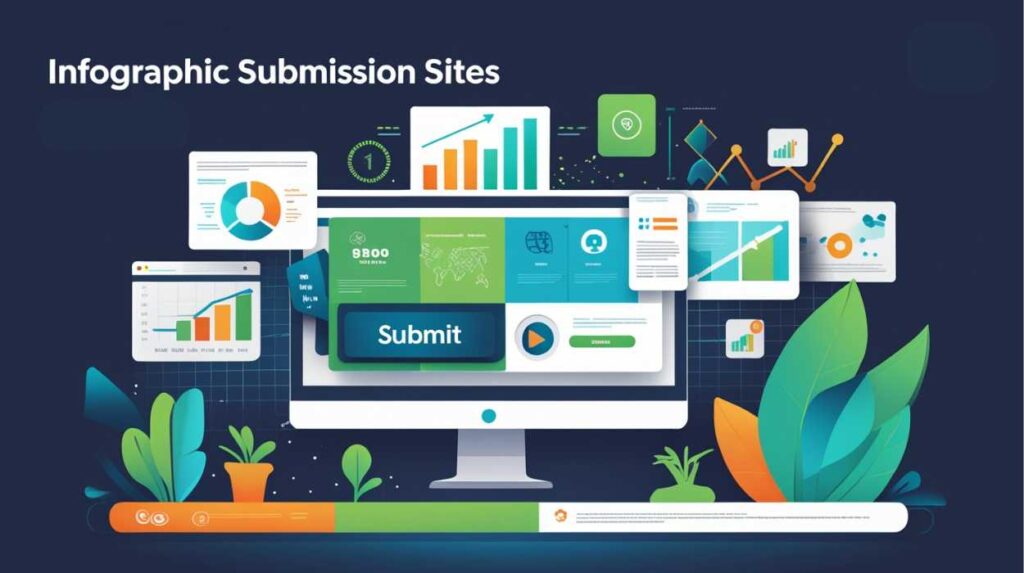Let’s be honest—writing long blog posts and building backlinks isn’t always fun or easy. That’s why using infographics can be such a smart move. They’re visual and straightforward, and people enjoy looking at them (unlike a big wall of text). But just creating a nice infographic isn’t enough—you’ve got to share it in the right places.
That’s where infographic submission sites come in. By uploading your infographics to these platforms, you can get valuable backlinks, more visibility for your content, and a boost in traffic—without spending hours on outreach or writing guest posts.
I’ve put together a helpful list of infographic submission websites you can start using right away. These are some of the best places (with decent domain authority) where marketers, bloggers, and even small business owners can share their visuals and build links. If you’re doing basic SEO for your blog or website, this is a simple trick you’ll want to add to your strategy.
What are Infographics
An infographic is a synthesis of text and visual media including pictures, graphs, and videos. It is an effective tool for organizing and explaining information as it presents complex topics in a very simplistic and engaging manner. Diagrams, charts, and statistics are changed into eye-catching images.
Infographics are easier to understand and characterize dense blocks of data. They are visually appealing and efficiently communicate information. Such graphics have a horizontal or vertical structure and a logical progression of components. They also include icons, illustrations, colors, and fonts.
Infographics can present complex information in a clear manner and have numerous applications including teaching, advertising, sharing information, brand marketing, etc.
What are Infographic Submission Sites?
Infographic submission sites are places on the web where users can submit or share their infographics to reach a wider audience. Such places are like a treasure trove for marketers, designers, educators, and businesses for building reach and visibility. Submission of infographics in such places can improve SEO, generate traffic toward a site, and create high-quality backlinks.
Most of the these sites have huge user bases that appreciate good, informative, and engaging content. They offer one-stop centers where users can find, share, and like different topics of infographics. Some of the popular infographic submission websites include Visual.ly, Infographic Journal, and Pinterest. Normally, infographics on these platforms are organized by topics, which helps users easily find content that interests them.
Why Infographic Submission Matters for Your Digital Strategy

- Expanded Reach Opportunities: The submission of infographics goes beyond just website traffic as it expands your reach considerably. Some audience-specific websites actively look for visual content and hosting graphics allows easy access to consumers that would never have learned of the brand. Infographic directory websites are one such medium that helps content creators reach targeted niche audiences.
- Indirect Backlink Submission: Backlink submission sites are known to provide spaces where users submit projects with cited works. These submissions greatly enhance your ranking as a visitor from a different domain and search engines already using those backlinks would depend on knowing them to declare them adept and relevant. Such links would be of great importance and fetch significant attention for that website, especially when done through high DA infographic submission platforms.
- Viral Marketing: Content that is visual performs better on social media as they are shared 40 times more than textual content. Social networks and infographic submission sites posting one piece of content means it will be disseminated on several platforms which will guarantee that the content is seen by a lot of people. Infographic SEO tools can also help in tracking how well your visuals perform across channels. You can also use ready-made templates to create consistent, optimized infographics more efficiently
- Company Reputation Boost: Posting in-depth informative graphics strengthens brand presence in the industry. Increasing perceived credibility is rather simple and can be done through trust accumulation, giving through customer loyalty and brand promise that leads to recovery trust along with increase in loyalty.
- Advertising without A Price Tag: Submitting infographics is not for paid advertisement because it is a more sustainable technique.
- Traffic Building: When you submit your infographics to such sites, you will be able to generate some good traffic back to your website. Interested viewers often click the links back to the source for further information.
- Brand Awareness: Regular uploading of high-quality infographics allows building both the online presence and brand awareness. It showcases your authority and recognizes your brand as an important resource in your niche.
SEO Benefits of Using Infographic Submission Sites
- Backlinks: One of the major SEO advantages of infographic submission is the generation of backlinks. Each time another site links back to your infographic, this acts as an indicator to search engines that your content is useful and credible and improves the authority and ranking of a site.
- Better Search Rankings: Several good quality backlinks along with more traffic work together to provide better search engine rankings. The search engines acknowledge your content as popular and relevant, thus helping to move up in SERP.
- Keyword Optimization: While submitting your infographics, there is an option for including relevant keywords within the title, description, and tags. This aids your content to become more visible across search engine results for the keywords used.
Key Features to Look for in an Infographic Submission Site
- High Domain Authority: Opt for those with good domain authority (50+) and with good web presence about which backlinking carries SEO link juice and a good rank in the search results, thereby making the content more visible to people and more credible.
- Relevant Category Structure: Select sites which offer industry categories or niches specific to your target audience. This puts your infographic in front of those users who are genuinely interested in it, hence higher engagement and conversion.
- User-Friendly Submission Process: Make sure to pick platforms that have an easy submission interface requiring no advanced technical knowledge. Drag-and-drop capabilities, clear guidelines, and an attentive support team help eliminate barriers to submission, allowing you to spot other priorities.
- Social Sharing Integration: Pick sites that sync automatically with major social media platforms, making it easy to share and spread. Social sharing buttons and widgets are instrumental in viral sharing across different social networks.
- Analytics and Tracking Capabilities: These are great qualities to have in submission sites: The more they track, the better-the number of views, clicks, shares, and overall engagement. From this data, you are enabled to see your ROI measurement, optimize submissions far into the future, and really grasp their preferences.
- Mobile Optimization: Look for a platform that can show your infographics perfectly on every device, especially on mobile, where traffic is on top.
High DA Infographic Submission Sites List
Advantages of Infographic Submission Sites
There are several advantages associated with infographic submission sites, especially in the eyes of marketers, content creators, and every other business-minded entity striving to maximize their presence on the web. Some of the main advantages include:
- Improved Visibility and Reach: In most cases, these sites display large, engaged audiences. Sharing your infographics across such platforms allows you to reach a wider audience, bringing more viewers and prospective followers to your content.
- Better SEO: Submit these infographics to the sites mentioned below to increase your SEO efforts exponentially. Most of the platforms like to have backlinks to the website, which will increase your domain authority and SERPs.
- Generation of Traffic: You can generate a large amount of traffic from infographics. If viewers find it useful and informative, they will surely want to learn more from you by visiting your website, which ultimately increases the traffic.
- Brand Awareness: If high-quality infographics are posted to the submission sites regularly, it will help in building up and strengthening your brand. More credibility and awareness get built for your brand as an expert in its respective niche.
- Engagement and Shareability: Since infographics are easily shared because of the nature of the visual appeal, they could share some hard-to-understand information in an easy format. There are great chances that your content might be shared on social media, hence improving your reach.
- Content Longevity: Infographics tend to have a greater shelf life compared with other types of content. They are capable of continuing to draw in views and shares months after their initial release, providing continuing value and engagement.
- Diverse Audience: Infographic submission sites have users across sectors and interests. This will help one leverage new audiences and give a better reach beyond the current following. Infographics break down information into simple bits that are easier to access and engage with the user. This could lead to better user experiences, higher engagement rates, and improved retentiveness.
- Cost-Effective Marketing: Marketing through infographic submission sites is fairly cost-effective. Most of the sites offer free submission options, so you would not have to spend huge amounts of money to leverage these platforms.
- Networking Opportunities: Very often, places like this help realize communities of people with similar interests and tastes. Being part of them will let you network with other creators, marketers, and industry professionals for probable collaboration and partnership opportunities.
How To Do Infographic Submission

- Explore target venues: Research relevant publications, platforms, or organizations that would consider accepting your submission.
- Assess submission requirements: Review the format instructions, word count, submission date, and any other accompanying requirements.
- Develop your content: Ensure that your writing is polished and meets the required quality standards.
- Adhere to formatting requirements: Ensure that the font, spacing, headers, and file type comply with the exact instructions.
- Compile all relevant documents: Gather the cover letter, abstract, author biography, and other supporting documents that are requested.
- Construct a submission package: Make sure that the documents have proper titles and that all files are labeled professionally.
- Perform final checks: Check that all required documents have been submitted according to instructions and ensure all criteria have been met.
- Follow pre-determined submission guidelines: Use submission portals, email addresses, or posted mail outlined in submission guidelines.
- Log all submission details: Document submission timings, venues, and note any correspondence to assist tracking follow-ups.
- Limit activities until response periods: Allow documented review timelines to take place before contacting.
- Evaluate submission feedback: Review correspondence with respect to acceptance, rejection, or revision requests for the appropriate response.
- Use stated review periods: Make contact with the submission venue in a professional manner only after defined timelines stated in review periods have lapsed.
Before You Submit: Best Practices for Infographic Success
- Comprehensive research with data verification: All statistics, facts, and claims contained in your infographic should be accurate and up to date and from credible publications. Always cite your sources and verify in more than one source the information to protect yourself from a blow coming from the misinformation.
- Professional Design Criteria: Apply professional design reflecting your brand identity while ensuring visual hierarchy and readability. Be consistent with the use of colors and typography so that your infographics will catch the eyes of clients as opposed to your competitors.
- Keyword Optimization: Add keywords to your keywords, title description, and tags relevantly but naturally. This makes sure your infographics will be found and cutters will have a good reading experience upon submission.
- File Specifications Optimization: The ideal size for infographics is around 800-1200 pixels wide. The best file format is PNG and JPEG. Large file sizes will be much slower to load and would be incompatible with various platforms and devices; hence keep the size down to below 2MB.
- Clear Value Proposition: The infographic must solve a problem pertinent to the target audience or answer frequently asked questions or offer a new insight from its perspective.
- Brand Cohesion: Brand recognition may be fortified by using subtle brand elements (logos, colors, and fonts). However, this must be done in such a way that does not take away from the educational value of the content or violate submission site guidelines.
Tracking Your Infographics Performance
- Integrated Analytics Tracking: The use of Google Analytics UTMs and tracking codes at the subdomain level allows for measurement of traffic source, behavior, and conversion monitoring. With this level of tracking, it is possible to discern which submission sites provide the best traffic and ROI quality.
- Engagement Metrics Evaluation: Measurement of likes, shares and comments along with CTR across all platforms to measure the level of audience engagement. Successful content strategy is achieved when engagement rates soar and assists in understanding what resonates with target audiences.
- Backlink Profile Analysis: Track new backlinks created through submissions using Ahrefs, SEMrush, or Moz. Quality backlinks have a significant impact on search ranking and domain authority which makes this metric essential when evaluating progress on SEO goals over time.
- Social Media Amplification Tracking: Analyze infographic mentions and shares across social networks through Hootsuite, Sprout Social, or the platform’s native analytics. This information contributes to understanding content virality and helps in planning content strategies.
- Tracking Changes in Conversion Rates: Measure if site visitors generated through submissions become potential leads, sales, or perform any other required action. This assists in evaluating the return on investment as well as determining which platform provides the most useful crowd for the business objectives.
Common Mistakes to Avoid
- Ignoring Platform-Specific Submission Guidelines: Each submission site has their own requirements with regard to file formats, dimensions, content policies, and submission processes. Not reading and following these guidelines leads to rejected submissions, wasted effort, and even account penalties.
- Over-Promotional Self Marketing Infographics: Infographics that go out of their way to promote a brand instead of creating value are either ignored or actively rejected by the audiences.
- Mobile Neglecting Optimizing Devices Infographics: Submitting infographics that are not optimized for mobile viewing significantly reduces potential reach and engagement. With mobile traffic accounting for over fifty percent of web traffic, this is critical.
- Cross-Channel Branding Inconsistency: Consistent use of logos , colors , messaging and taglines of different submission sites helps boost brand recognition. Using different across the submission sites tend to confuse audiences and dilute brand recognition.
- Failing to Engage After Submission: Submitting and forgetting about infographics leads to numerous unwatched opportunities to use comments, sharing on social channels, or viewing performance data which prevents optimizing and building brand trust.
- Over Posting and Under Posting: Submitting too frequently is considered spammy while under submitting wastes platform relationships.
Final Words
Submitting infographics to the right platforms is a quick and effective way to get more eyes on your content, earn quality backlinks, and improve your site’s SEO performance—even if you’re not an expert. The key is consistency: create good visuals, write short and clear descriptions, and use the submission sites regularly.
Whether you’re a blogger, digital marketer, or just running your own small business, using infographic submission sites can be a game-changer in building online presence without overcomplicating things.
Pick a few sites from the list, give it a try, and see the difference. Over time, these small efforts can bring steady improvements to your traffic, rankings, and brand authority.
Start submitting today—and let your infographics speak for you!
FAQs
1. What are infographic submission sites?
Answer: These are online platforms where a user can share infographics with a more significant number of audiences. These sites increase the visibility and drive traffic to your website, which benefits the SEO of your website through backlinks.
2. How do the infographic submission sites benefit my content marketing?
These sites increase your content marketing by increasing the reach of your content, attracting more viewers to your content, generating backlinks, and driving traffic to your website. It also helps in building brand awareness and authority establishment in your niche.
3. Are infographic submission sites free to use?
Answer: Most of the infographic submission sites are free, but some of them require premium prices for some extra features and services. Be sure to check on the terms of use available on each of the sites stating what is provided in their free vs. paid options.
4. What kind of infographics am I allowed to submit?
- Answer: You can send in almost any kind of infographic that relates to any topic such as education, health, finance, technology, marketing, and many more. Just be sure it has relevance to the audience of that site and the style and guidelines for submission.
5. How can I sign up on infographic submission sites?
Go to the website; find the button that says “Sign Up” or, in some cases, “Register”. Fill in your information and provide your name, email address, and password. Then, if requested, confirm your e-mail and fill out your profile. Now you are all set and ready to go: you can start submitting your infographics.

